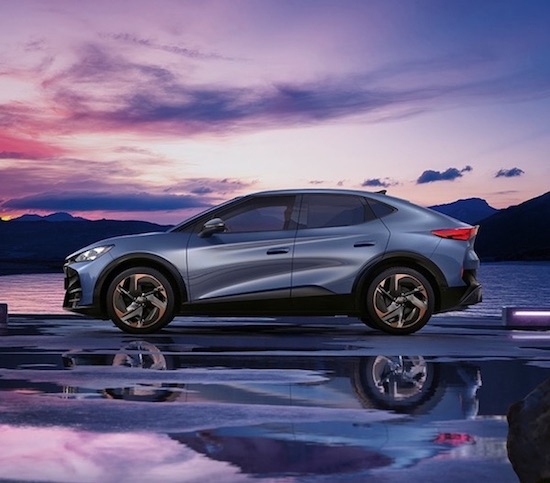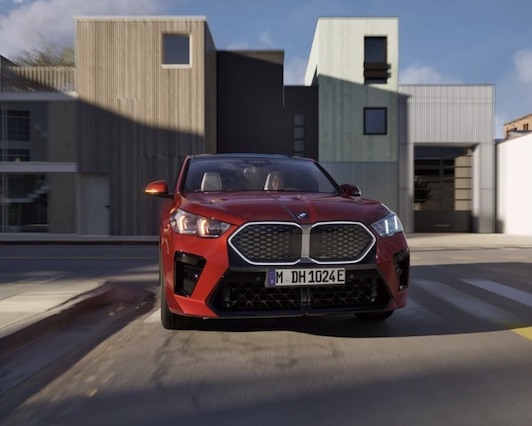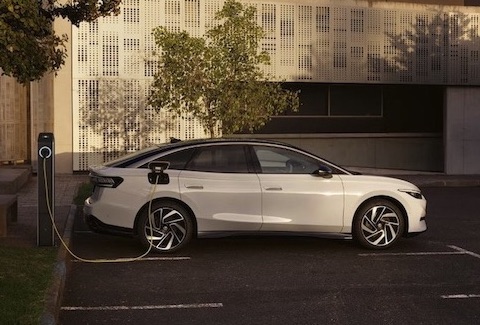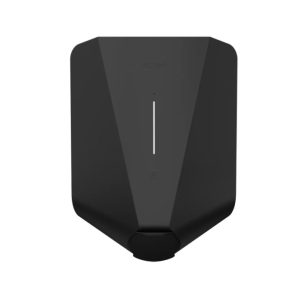Overview
SEAT CUPRA, S.A.U, simply known as CUPRA, is the high-performance motorsport subsidiary of SEAT S.A., Spain’s first family car manufacturer. The automotive company was founded in 1950 and is headquartered in Martorell, Spain.
In 1986, SEAT was sold to the German automotive group, Volkswagen A.G. CUPRA was previously known as SEAT Sport. The high-performance CUPRA brand was created in 2018. The manufacturer is committed to becoming a fully-electric brand by 2030. CUPRA is expected to introduce the all-electric CUPRA Terramar and the all-electric CUPRA UrbanRebel in due course. The company has the following portfolio of plug-in hybrid electric vehicles (PHEVs) and battery-electric vehicles (BEVs):
- CUPRA Formentor e-HYBRID
- CUPRA Leon e-HYBRID
- CUPRA Leon Estate e-HYBRID
- All-electric Cupra Born
- All-electric Cupra Tavascan
Electric Cars: The Basics
For those of you new to zero-emission electric driving, we recommend a read of the following articles:
Sign up to the e-zoomed Electric Living newsletter
The All-Electric CUPRA Tavascan SUV Coupé
The all-electric Tavascan is the second battery-electric vehicle (BEV), and the first pure electric SUV coupé from CUPRA. The first all-electric CUPRA car is the CUPRA Born e-hatchback. CUPRA, like other automotive manufacturers, is keen to capitalise on the robust demand for SUVs, in particular, premium electric SUVs.
The Tavascan concept vehicle was first shown at the Frankfurt Motor Show (IAA) in 2019. Confirmation of production was announced in March 2021, followed by the official launch in April 2023. The electric vehicle (EV) also uses the Volkswagen electric vehicle (EV) dedicated MEB (Modular electric drive matrix) platform, which is also used by CUPRA Born and the Volkswagen ID.Family of electric vehicles. The all-electric VW ID.3, VW ID.4 and VW ID.7 are examples of EVs that share the MEB platform.
Though the electric Tavascan has been designed and developed in Spain (Barcelona), it is being manufactured in China at the Volkswagen Anhui production plant. The Anhui plant was established by the Volkswagen Group and JAC Automobile Group in 2017. VW currently owns 75% of this production facility. Deliveries for the Tavascan are slated for 2024, with CUPRA targeting an annual production up to 70,000 vehicles.
The Tavascan will be available as both, a rear-wheel drive (RWD), and a higher-performance, all-wheel drive (AWD) variant. The AWD variant, the CUPRA Tavascan VZ incorporates dual-motors (210 kW rear motor/ 80 kW front motor). The Tavascan VZ can achieve 0-62 mph in 5.6 seconds (not bad, given the length of the SUV: 4.6m). The EV delivers a maximum power up to 340 PS and 545 Nm torque.
The entry-level Tavascan RWD can achieve 0-62 mph in 6.8 seconds. The EV delivers a maximum power up to 285 PS and 545 Nm torque. The top speed is 111 mph. The Tavascan EV offers a range of CUPRA driving modes, to include: Range, Comfort, Performance, CUPRA, Individual and Traction. The traction mode is only on the AWD variant. The EV features DCC Sport dynamic chassis technology, sport suspension and progressive steering.
The CUPRA Tavascan EV is available in one EV battery size: 82 kWh (77 kWh net). The lithium-ion EV battery has a claimed range up 339 miles (WLTP) for the real-wheel drive (RWD) variant and up to 321 miles for the all-wheel drive (AWD) variant. Of course, these will need to be adjusted for real-world driving conditions, like weather, temperature, speed, payload, road conditions etc. Expect up to 285 miles for the Tavascan RWD and up to 270 miles for the Tavascan AWD.
By way of comparison, the Chinese all-electric Genesis GV70 SUV has a 77.4 kWh onboard EV battery with a range up to 283 miles (WLTP). The AWD GV70 can achieve 0-60 mph in 4.2 seconds using the boost function (490 PS). The GV70 EV is longer (4.7m) than the Tavascan EV (4.6m).
The EV battery is placed on the floor of the Tavascan EV, lowering the centre of gravity. It is housed in an aluminium structure (part of the EV body), increasing the rigidity, and is positioned between the axles to improve the weight distribution of the vehicle (49:51). Of course, this is not unique to the Tavascan EV. Other pure electric cars also follow a similar approach!
As is the case with electric cars, the Tavascan also benefits from regenerative braking. The 4 levels of regen can be controlled via the ‘regenerative paddle shifts’ on the steering wheel. For those keen to increase electric range, best to choose the strongest energy recuperation level. Also available as an option to increase the efficiency of the EV is an onboard heat pump, which reduces the demand on the onboard EV battery. Given the premium segment of the CUPRA performance brand, we would have expected the heat pump as standard equipment in the EV!
The EV is capable up to 135 kW DC rapid charging, and the 82 kWh EV battery can be charged up to 80% in 30 minutes. Put another way, 62 miles can be added in 7 minutes. Though 135 kW DC is adequate for public DC charging, it is surprising that CUPRA does not offer a faster DC charging capability. Many of the recent premium electric cars offer up to 350 kW DC charging capability. As an example, the Genesis electric cars offer up to 350 kW DC ultra-rapid EV charging capability as standard.
The Tavascan electric car has an 11 kW AC onboard charger as standard, which is certainly an advantage for those charging destinations with 3-phase power supply (home and workplace). We at e-zoomed recommend a ‘topping up’ approach to charging an electric car. This way to fully charge the EV will take shorter times and regular charging is good for the long-term maintenance of the EV battery. CUPRA offers an EV battery warranty up to 8 years or 100,000 miles. Quite similar to most other EV manufacturers.
The CUPRA Tavascan EV is packed with technology, to include, a suite of advanced assisted driving systems: predictive adaptive cruise control, traffic sign recognition, intelligent speed adaptation, side assist, lane assist, exit warning, fatigue detection, rear view camera and more! Also on offer is assisted parking which enables remote parking of the EV via a smartphone.
For those in need of more assistance for parking, there is also the trained parking functionality which completely assists the driver 50m ahead of a parking space that has been memorised in the EV. As standard is a responsive 15″ navigation system, also used by the all-electric VW ID.7 saloon. The infotainment system integrates a newly designed Human Machine Interface (HMI).
The exterior coupé silhouette of the SUV does not disappoint. According to the manufacturer, the Tavascan marks an important shift for CUPRA in terms of a more striking design language. We agree! Of course, not only does the new design language increase the appeal of the EV, but also improves the aerodynamics of the vehicle. The front incorporates matrix LED lights with a three-triangle eye signature. For the more traditional automotive buyer, the sporty exterior styling of the e-SUV maybe too aggressive!
In terms of the interior, the EV is equipped with bucket seats as standard, and incorporates sustainable materials (up to 90% recycled polyester and 50% recycled microfibre). As expected, the premium electric car offers a range of interior lighting options with LED used throughout the interior, to include ’emotional ambient lighting’. In terms of practicality, the EV offers up to 540 L boot space.
Company-car drivers can also take advantage of the lower Benefit-in-Kind (BiK-2%) tax rate for the electric car. Bottom-line, electric driving is good for the environment and the wallet! You can lease electric vehicles (EVs) via e-zoomed at very competitive prices!
| PROS | CONS |
|---|---|
| Decent onboard EV battery size and e-range | DC charging limited to 135 kW DC |
| Technology-filled | Heat pump not as standard |
| RWD and AWD variants | Limited exterior colour options |
The All-Electric CUPRA Tavascan SUV Coupé (credit: CUPRA)
| At A Glance | |
|---|---|
| EV Type: | Battery-Electric Vehicle (BEV) |
| Body Type: | SUV (Coupé) |
| Plug-In Car Grant (PiCG): | N/A |
| Engine: | Electric |
| Available In UK: | Yes |
| Variants (2 Options) |
|---|
| CUPRA Tavascan RWD (from £ N/A) |
| CUPRA Tavascan AWD (from £ N/A) |
| EV Battery & Emissions | |
|---|---|
| EV Battery Type: | Lithium-ion |
| EV Battery Capacity: | Available in one battery size: 82 kWh |
| Charging: | 135 kW DC rapid charging (10%-80% SOC: 30 mins). Onboard charger 11 kW AC (0%-100%: N/A) |
| Charge Port: | Type 2 |
| EV Cable Type: | Type 2 |
| Tailpipe Emissions: | 0g (CO2/km) |
| EV Battery Warranty: | 8 years or 100,000 miles |
| Dimensions | |
|---|---|
| Height (mm): | 1597 |
| Width (mm): | 1861 |
| Length (mm): | 4644 |
| Wheelbase (mm): | 2766 |
| Turning Circle (m): | N/A |
| Boot Space (L): | 540 |
| Average Cost Of Residential Charging | |
|---|---|
| Battery net capacity : 16.7 kWh | £2.40 |
| Battery net capacity : 30.0 kWh | £4.32 |
| Battery net capacity : 39.2 kWh | £5.64 |
| Battery net capacity : 45.0 kWh | £6.48 |
| Battery net capacity : 50.0 kWh | £7.20 |
| Battery net capacity : 64.0 kWh | £9.22 |
| Battery net capacity : 71.0 kWh | £10.22 |
| Battery net capacity : 77.0 kWh | £11.09 |
| Battery net capacity : 90.0 kWh | £12.96 |
| Battery net capacity : 100.0 kWh | £14.40 |
- Note 1: The average cost of residential electricity in the UK varies depending on the region, supplier and type of energy used. An average for the UK is 14.40 p/kWh.
- Note 2: Not all EV manufactures make available the data on net EV battery capacity, and in a number of instances the EV battery capacity advertised, does not state if it is gross or net capacity. In general, usable EV battery capacity is between 85% to 95% of the gross available capacity.
| Charging Times (Overview) | |
|---|---|
| Slow charging AC (3 kW – 3.6 kW): | 6 – 12 hours (dependent on size of EV battery & SOC) |
| Fast charging AC (7 kW – 22 kW): | 3 – 8 hours (dependent on size of EV battery & SoC) |
| Rapid charging AC (43 kW): | 0-80%: 20 mins to 60 mins (dependent on size of EV battery & SoC) |
| Rapid charging DC (50 kW+): | 0-80%: 20 mins to 60 mins (dependent on size of EV battery & SoC) |
| Ultra rapid charging DC (150 kW+): | 0-80% : 20 mins to 40 mins (dependent on size of EV battery & SoC) |
| Tesla Supercharger (120 kW – 250 kW): | 0-80%: up to 25 mins (dependent on size of EV battery & SoC) |
- Note 1: SoC: state of charge
| Tavascan | |
|---|---|
| EV Battery Capacity: | 82 kWh |
| Pure Electric Range (WLTP): | 339 miles |
| Electric Energy Consumption (kWh/100 km): | 15.6 |
| Charging: | 135 kW DC rapid charging (10%-80% SOC: 30 mins). Onboard charger 11 kW AC (0%-100%: N/A) |
| Top Speed: | 111 mph |
| 0-62 mph: | 6.8 seconds |
| Drive: | Rear-wheel drive (RWD) |
| Max Power (PS): | 285 (210 kW) |
| Torque (Nm): | 545 |
| Transmission: | Automatic |
| Seats: | 5 |
| Doors: | 5 |
| Kerb Weight (kg): | N/A |
| Colours: | 4 |
| NCAP Safety Rating: | N/A |
| Tavascan VZ | |
|---|---|
| EV Battery Capacity: | 82 kWh |
| Pure Electric Range (WLTP): | 321 miles |
| Electric Energy Consumption (kWh/100 km): | 16.6 |
| Charging: | 135 kW DC rapid charging (10%-80% SOC: 30 mins). Onboard charger 11 kW AC (0%-100%: N/A) |
| Top Speed: | 111 mph |
| 0-62 mph: | 5.6 seconds |
| Drive: | All-wheel drive (AWD) |
| Max Power (PS): | 340 (250 kW) |
| Torque (Nm): | 545 |
| Transmission: | Automatic |
| Seats: | 5 |
| Doors: | 5 |
| Kerb Weight (kg): | N/A |
| Colours: | 4 |
| NCAP Safety Rating: | N/A |
While e-zoomed uses reasonable efforts to provide accurate and up-to-date information, some of the information provided is gathered from third parties and has not been independently verified by e-zoomed. While the information from the third party sources is believed to be reliable, no warranty, express or implied, is made by e-zoomed regarding the accuracy, adequacy, completeness, legality, reliability or usefulness of any information. This disclaimer applies to both isolated and aggregate uses of this information.










































